Sunday, March 2, 2008
No. 119 - Cohn-Goldwater Building
Cohn-Goldwater Building
1909
525 East 12th Street – map
Declared: 5/16/73
So, how many times have you been at the corner of San Julian and East 12th in the Fashion District, looked up, and thought, “Gosh, I sure hope that giant box is a Los Angeles Historic-Cultural Monument?” My guess is, never.
For just $150,000, Lemuel Goldwater and Morris Cohn put up this building in 1909 for their clothing company. What makes it special is that it’s Los Angeles’s first modern steel-reinforced concrete factory building. The structure’s roomy, too; ZIMAS lists it as having nearly 80,000 square feet.
Here’s an early picture of the landmark, thanks to USC’s Digital Archive. Sadly, that columnated awning is gone.
And, below, from the city’s Department of City Planning website, is a shot taken sometime after the 1973 designation when it was home to Central City Mini-Storage.
This part, on the San Julian side, looks like the oldest part of the monument's facade:
Today, as you can see above, the Cohn-Goldwater Building is home to a variety of apparel-related tenants, from Funkyberry to ASSA, an unfortunate acronym if I’ve ever heard one. The good news is the building, after a century, is back being part of L.A.’s garment industry, even if this ASSA wasn’t the ASSA I assumed it’d be.
Up next: Saint Sophia Cathedral
Posted by
Floyd B. Bariscale
at
8:37 PM
![]()
Labels: Central City
Subscribe to:
Post Comments (Atom)
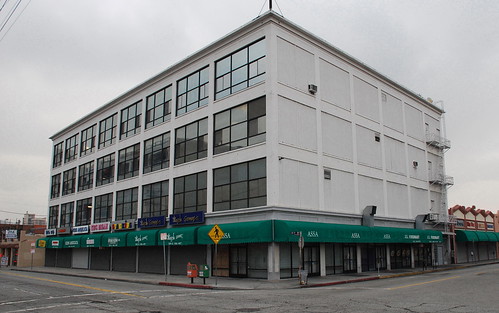
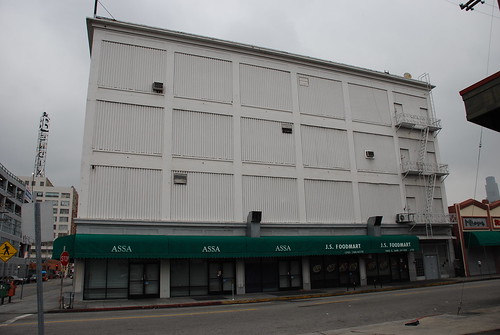
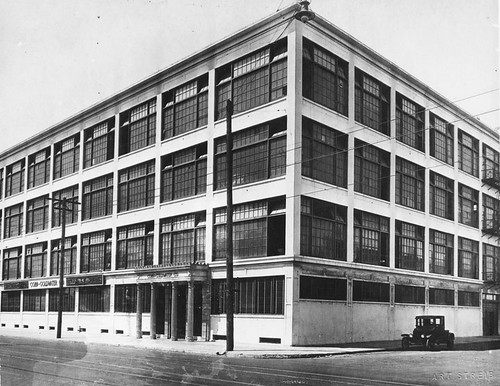

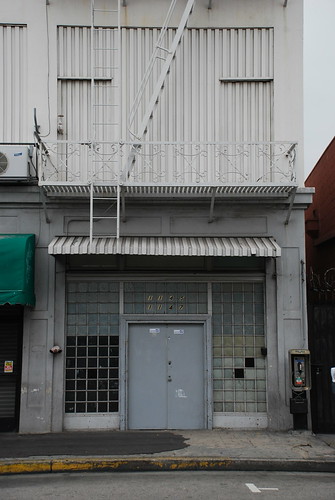
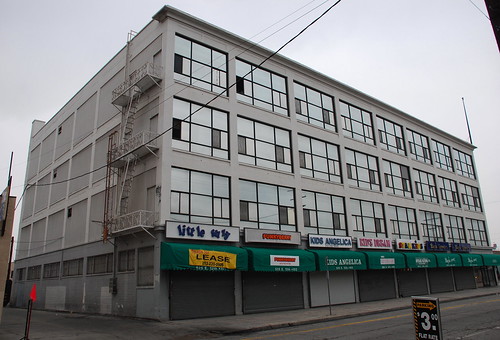
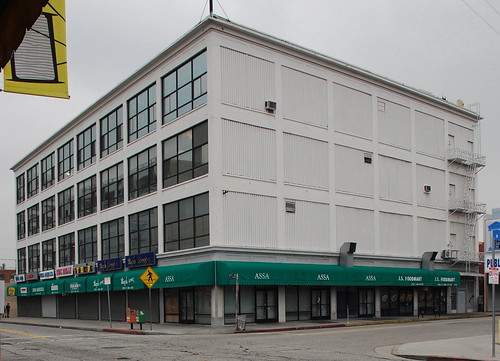

10 comments:
Ok, not to be persnickety, but I’m going to persnick, or pick nits, or whatever. Having reinstalled windows on one side, which of course must be appreciated, could they not have at least attempted a rough reproduction of the original fenestration? (I won’t even be so bold as to mention that it would have been nice if they'd restored the San Julian-side windows while they were, you know, at it.) And the columnated awning disappeared AFTER the 1973 designation? I evidently have a poor grasp of Historic-Cultural Monument status, which I thought had at least something to do with façade protection. After all, the façade was pretty intact—painting over the fire escapes was pointless, but reversible—but what’s with the whole “blow out the entire ground floor to install shops” that, again, occurred post-designation? (Of course, those shops cater to the demands of the infantocracy, all hail Little Suzy and the Star Kids.)
Nathan, I thought the same thing about the archway. It was either removed without the city's knowing, or it was removed for what the city saw as a good reason, which may be the case. And that first-floor alteration should've been avoided, I agree. Maybe the point of view here is as long as the historical framework is left alone, the facade is fair game.
I too am unsure of how Historical Cultural Monument status works. A case in point is the 1932 Olympic Swim Stadium near USC. A structure that was nearly lost due to the idea of making room for more parking. Anyhow, they kept the facade and removed all else. The interior was replaced with three floors of a multi use facility (L.A. Recreation and Parks?). I believe the same is true of the location of the new Whole Foods in Pasadena. C.W. Driver contractors worked on both projects. Perhaps this is the new trend.
Hey, Palm Axis. Is the Stadium an official city landmark?
Floyd,
I went on line to find out if it is indeed an official city landmark, but sadly, came away confused. I can only assume it would be. It's of historical interest and it's located in Exposition Park. Go see it and bring your camera.
I was just thinking about this very point, PA's point about the trend—while driving by S. Charles Lee’s La Reina theater, HCM #290…whose interior was completely gutted for shops two years after its designation. As more structures are landmarked, more will be reworked like the Whole Foods/auto garage, ’course, for some reason, cities have a fetish of bending over backwards for, of all things, nightclubs. Nightclubs will gut any structure they possibly can, then disappear. I foresee a lot of cranky developers in the coming years buying up structures to do the parking garage thing too. (Plus there’s this new deal where you take a vintage building and plop some absurd thing on top a la the 1925 Morgan, Walls & Clements Fuller Paint Company in Lincoln Heights -- http://www.flickr.com/photos/tulane22/2305363169/sizes/o/ ) ...of course, none of this can explain why façade elements go missing…La Reina’s vertical neon blade had to be removed after Northridge. That at least is a matter of record. Of the mysteries of Cohn-Goldwater we have less understanding than of the mysterious 1968 workings of the Ambassador’s pantry...the archway could have been removed because it was unsafe, but let's be honest, it could have been shored up without the use of brain surgery or rocket science. But what do we know? Maybe a truck backed into it. But Floyd, when you talk about the facade as fair game as long as "they" leave the "historical framework" alone, I do worry about "they." What can they sacrifice? What constitutes historical framework? The massing? The dominant massing? May we sacrifice subordinate massing (if not decoration) to the whole? Then they needn’t be bothered with all that bothersome conservation junk, with the concerns over detailing and proper replacement and use of materials and jeez, height and scale and signs and lighting to boot…anyway…
Palm Axis, I need to visit No. 127, the Exposition Club House real soon, so I'll do what you suggest. Thanks a ton.
Okay, first, let's agree the city had to have known and approved this alteration. It was crazy of me to suppose otherwise. Second, I don't have the original application for the Cohn-Goldwater Building, but, from what I see, it was the steel and concrete framework that made this building significant. Maybe in the city's eyes, as long as this wasn't screwed with, the owners were given more room to alter the facade. That's more of an excuse than a justification, of course. Finally, you've clearly got more of a grasp of this issue than I, but it's just as clear the protection of these HCMs isn't necessarily concrete (even when the landmarks are). Let's wait until Cole's reopens.
I agree with everything you say—it’s that the city DID know and approve that gets me. Speaking of original applications, do you know where they reside…is there some city repository for them somewhere? They would be most interesting to gander at… But as for my having a grasp of anything, jeez, did my rambling fool you? What can I say, steel and concrete get me all a-twitter.
It wasn't the rambling that fooled me; it was "fenestration", "infantocracy", and spelling facade with the fancy 'c'. The HCM applications and files are available at the Office of Historic Resources in the city's Department of Planning. I've been in touch with them, but haven't, yet, been there. I'll need to, though, as information on many of the upcoming monuments is scarce.
Post a Comment